Abstract
Multiple introductions are hypothesized to facilitate the success of invasive plant species, because they can result in novel genotypes through intraspecific hybridization potentially increasing the ability to adapt to the novel environment. In this study, we address the question of how the demography of an invader with multiple introductions and intraspecific hybridization varies across sites. This was done by modeling the population dynamics of Brazilian pepper, Schinus terebinthifolia Raddi (Anacardiaceae), a shrub native to Brazil, Paraguay and Argentina that has invaded the global subtropics and was introduced to Florida on two separate occasions. This species exhibits variability in growth form such that vertical and lateral growth are not strongly associated. Our demographic field work took place at six sites spanning the introduced range in Florida and differing in introduction history. For each site we constructed integral projection models where the probabilities of survival, growth and reproduction were modeled as functions of two different metrics of size, the continuous variables diameter and height, metrics of vertical and lateral growth, respectively. We performed a Life Table Response Experiment analysis to decompose the effects of variation among sites in vital rates on the population dynamics of S. terebinthifolia. We found that spatial variation in population dynamics was driven primarily by site-level differences in the maturation of seedlings into reproductive adults. The survival and growth of the largest individuals had the highest elasticity, suggesting that management actions capable of decreasing these vital rates would have the greatest effect on reducing the population growth rate.









Similar content being viewed by others
References
Bates D, Maechler M (2017) Matrix: sparse and dense matrix classes and methods, R package version 1.2-1. https://CRAN.R-project.org/package=Matrix
Buckley YM, Briese DT, Rees M (2003) Demography and management of the invasive plant species Hypericum perforatum II. Construction and use of an individual-based model to predict population dynamics and the effects of management strategies. J Appl Ecol 40:494–507
Caswell H (2001) Matrix population models. Sinauer, Sunderland
Claridge K, Franklin SB (2002) Compensation and plasticity in an invasive plant species. Biol Invasions 4:339–347
Cuda J, Ferriter A, Manrique V, Medal J (2006) Interagency Brazilian peppertree (Schinus terebinthifolius) management plan for Florida, recommendations from the Brazilian peppertree task force. Florida Exotic Pest Plant Council. Technical report, South Florida WAter Management District, West Palm Beach, FL
Culley T, Hardiman NA (2009) The role of intraspecific hybridization in the evolution of invasiveness: a case study of the ornamental pear tree Pyrus calleryana. Biol Invasions 11:1107–1119
Dauer J, Jongejans E (2013) Elucidating the population dynamics of Japanese Knotweed using integral projection models. PLoS ONE 8:e75181
DeWalt SJ (2006) Population dynamics and potential for biological control of an exotic invasive shrub in Hawaiian rainforests. Biol Invasions 8:1145–1158
Easterling M, Ellner S, Dixon P (2000) Size-specific sensitivity: applying a new structured population model. Ecology 81:694–708
Elderd BD, Miller TEX (2016) Quantifying demographic uncertainty: Bayesian methods for integral projection models. Ecol Monogr 86:125–144
Ellner SP, Rees M (2006) Integral projection models for species with complex demography. Am Nat 167:410–428
Erickson KD (2017) Spatiotemporal variation in frugivore assemblages and population dynamics of an invasive shrub, Schinus terebinthifolius. Ph.D. thesis, University of Miami
Erickson KD, Pratt PD, Rayamajhi MB, Horvitz CC (2017) Introduction history influences aboveground biomass allocation in Brazilian Peppertree (Schinus terebinthifolius). Invasive Plant Sci Manag 10:247–253
Ewel J, Ojima D, Karl D, DeBusk W (1982) Schinus in successional ecosystems of Everglades National Park. Technical report T-676, Everglades National Park, South Florida Research Center
Florida Automated Weather Network (2019) https://fawn.ifas.ufl.edu/. Accessed 19 June 2019
Franco M, Silvertown J (2004) A comparative demography of plants based upon elasticities of vital rates. Ecology 85:531–538
Gaskin JF (2017) The role of hybridization in facilitating tree invasion. AoB Plants 9:plw079
Geiger J, Pratt P, Wheeler G, Williams D (2011) Hybrid vigor for the invasive exotic Brazilian peppertree (Schinus terebinthifolius Raddi, Anacardiaceae) in Florida. Int J Plant Sci 171:655–663
Genz A, Bretz F, Miwa T, Mi X, Leisch F, Scheipl F, Hothorn T (2018) mvtnorm: multivariate normal and t distributions, r package version 1.0-8. https://CRAN.R-project.org/package=mvtnorm
Goldstein EA, Butler F, Lawton C (2015) Frontier population dynamics of an invasive squirrel species: do introduced populations function differently than those in the native range? Biol Invasions 17:1181–1197
Govindarajulu P, Altwegg R, Anholt BR (2005) Matrix model investigation of invasive species control: bullfrogs on Vanvouver Island. Ecol Appl 15:2161–2170
Grotkopp E, Rejmanék M (2007) High seedling relative growth rate and specific leaf area are traits of invasive species: phylogenetically independent contrasts of woody angiosperms. Am J Bot 94:525–532
Havens K, Jolls CL, Knight TM, Vitt P (2019) Risks and rewards: assessing the effectiveness and safety of classical invasive plant biocontrol by arthropods. Bioscience 69:247–258
Horton JL, Neufeld HS (1998) Photosynthetic responses of Microstegium vimineum (Trin.) A. Camus, a shade-tolerant C\(_4\) grass, to variable light environments. Oecologia 114:11–19
Horvitz CC, Denslow JS, Johnson T, Gaoue O, Uowolo A (2018) Unexplained variability among spatial replicates in transient elasticity: implications for evolutionary ecology and management of invasive species. Popul Ecol 60:61–75
Hyatt LA, Araki S (2006) Comparative population dynamics of an invading species in its native and novel ranges. Biol Invasions 8:261–275
Jongejans E, Shea K, Skarpaas O, Kelly D (2008) Dispersal and demography contributions to population spread of Carduus nutans in its native and invaded ranges. J Ecol 96:687–697
Jongejans E, Shea K, Skarpaas O, Kelly D, Ellner S (2011) Importance of individual and environmental variation for invasive species spread: a spatial integral projection model. Ecology 92:86–97
Kolbe JJ, Gor RE, Rodriguez Schettino L, Chamizo Lara A, Larson A, Losos JB (2004) Genetic variation increases during biological invasion by a Cuban lizard. Nature 431:177–181
Koop AL, Horvitz CC (2005) Projection matrix analysis of the demography of an invasive, nonnative shrub Ardisia ellpitica. Ecology 86:2661–2672
Lewis MA (2000) Spread rate for a nonlinear stochastic invasion. J Math Biol 5:430–454
Morton J (1978) Brazilian pepper-its impact on people, animals and the environment. Econ Bot 32:353–359
Mukherjee A, Williams D, Wheeler G, Cuda J, Pal S, Overholt W (2012) Brazilian peppertree (Schinus terebinthifolius) in Florida and South America: evidence of a possible niche shift driven by hybridization. Biol Invasions 14:1415–1430
Parker IM (2000) Invasion dynamics of Cytissus scoparius: a matrix model approach. Ecol Appl 10:726–743
Pergl J, Pyšek Perglová P, Dietz H (2006) Population age structure and reproductive behavior of the monocarpic perennial Heracleum mantegassianum (Apiaceae) in its native and invaded distribution ranges. Am J Bot 93:1018–1028
Pimentel D, Zuniga R, Morrison D (2005) Update on the environmental and economic costs associated with alien-invasive species in the United States. Ecol Econ 52:273–288
R Core Team (2018) R: a language and environment for statistical computing. R Foundation for Statistical Computing, Vienna, Austria, https://www.R-project.org/
Raghu S, Osunkoya O, Pichancourt J (2014) Historical demography of Lantana camara L. reveals clues about the influence of land use and weather in the management of this widespread invasive species. Basic Appl Ecol 15:565–572
Rejmánek M, Richardson DM (1996) What attributes make some plant species more invasive? Ecology 77:1655–1661
Spector T, Putz FE (2006) Biomechanical plasticity facilitates invasion of maritime forests in the southern USA by Brazilian pepper (Schinus terebinthifolius). Biol Invasions 8:255–260
Stebbins GL (1950) The role of hybridization in evolution. Proc Am Philos Soc 103:231–251
Stevens J, Beckage B (2010) Fire effects on demography of the invasive shrub Brazilian pepper (Schinus terebinthifolius) in Florida pine savannas. Nat Areas J 30:53–63
Swope SM, Satterthwaite WH (2012) Variable effects of a generalist parasitoid on a biocontrol seed predator and its target weed. Ecol Appl 2012:20–34
Thomson DM (2017) Do source-sink dynamics promote the spread of an invasive grass into a novel habitat? Ecology 88:3126–3134
Tobe J, Craddock Burks K, Cantrell R, Garland M, Sweeley M, Hall D, Wallace P, Anglin G, Nelson G, Cooper J, Bickner D, Gilbert K, Aymond N, Greenwood K, Raymond N (1998) Florida wetland plants: an identification manual. Florida Department of Environmental Protection, Florida
USDA NRCS Web Soil Survey (2019) https://websoilsurvey.nrcs.usda.gov. Accessed 30 July 2019
van Kleef H, Jongejans E (2014) Identifying drivers of pumpkinseed invasiveness using population models. Aquat Invasions 9:315–326
Williams D, Overholt W, Cuda J, Hughes C (2005) Chloroplast and microsatellite DNA diversities reveal the introduction history of Brazilian peppertree (Schinus terebinthifolius) in Florida. Mol Ecol 14:3643–3656
Williams D, Muchugu E, Overholt W, Cuda J (2007) Colonization patterns of the invasive Brazilian peppertree, Schinus terebinthifolius, in Florida. Heredity 98:284–293
Acknowledgements
We wish to thank L. Kasarjian for field assistance and logistical assistance in accessing the demography study plots. We would also like to thank J. Geiger, E. Mattison, J. Ledi, R. Moscat, L. Witek, K. Sealey, B. Zhang, D. Weidemann, N. Martinez, S. Baguidy, R. Little, A. Villat, D. Farag and V. Vargas for field assistance. We are also grateful for collaborators who helped facilitate site access: D. Hall of the USDA’s US Horticulture Research Laboratory in Fort Pierce, J. Aspiolea and T. Smith at Charlotte Harbor Preserve State Park, C. Stylianos of the South Florida Water Management District, H. Cooley from Everglades National Park, and C. Olson and H. Joergens from Lee County Conservation 20/20. Thanks to the National Park Service (Permits BICY-00061 and EVER-00335) and Florida Department of Environmental Protection (Permit 01211514) for permitting this project. This work was supported in part by a forEverglades Scholarship (Everglades Foundation) as well as a Kushlan award from the Department of Biology (University of Miami). K. D. Erickson was supported by funding from the James W. McLamore Fellowship (University of Miami).
Author information
Authors and Affiliations
Corresponding author
Additional information
Publisher's Note
Springer Nature remains neutral with regard to jurisdictional claims in published maps and institutional affiliations.
Electronic supplementary material
Below is the link to the electronic supplementary material.
Rights and permissions
About this article
Cite this article
Erickson, K.D., Pratt, P.D., Rayamajhi, M.B. et al. Seedling maturation drives spatial variability in demographic dynamics of an invader with multiple introductions: insights from an LTRE analysis. Biol Invasions 22, 2185–2203 (2020). https://doi.org/10.1007/s10530-020-02249-x
Received:
Accepted:
Published:
Issue Date:
DOI: https://doi.org/10.1007/s10530-020-02249-x




